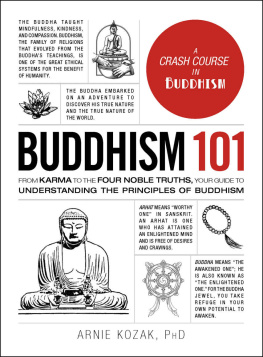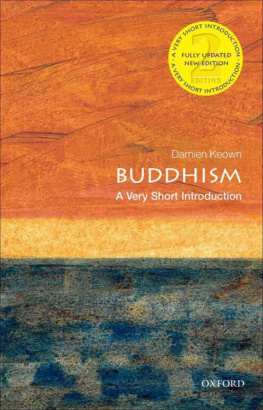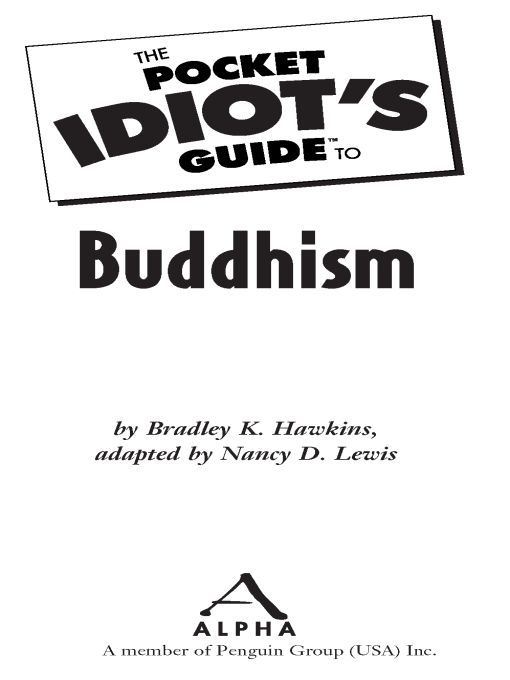Table of Contents
Introduction
This is perhaps the appropriate place to comment on what you, as the reader, hold in your hands. It is a key to the treasures of one of the oldest and most fascinating religions of humanity. As such, it is aimed at providing the novice reader with a brief overview of philosophy, history, and (most important) the feel of Buddhism. But it is only the first of many keys to a vast treasury.
Because, as you are about to find out, Buddhism has changed and developed considerably over the 2,500 years of its existence, the treatment of each individual topic must necessarily be brief. Fortunately, the reader who wants to delve more deeply into the ocean of Buddhism will find no lack of more detailed studies on almost any conceivable topic of interest.
The Buddhists have a saying to the effect that after people have had the moon pointed out to them, the help of a pointing finger is no longer required. It is our hope that this small offering will be like that pointing finger, useful for your discovery of one of the noblest products of the human spirit.
Extras
The sidebars in this book offer extra information and help to explain the topics and terms throughout the book. Use these as road signs on the journey to understanding Buddhism.
On the Right Path
These boxes provide guidance about Buddhism, which supplement the materials in the text. They take a topic one step further toward understanding the religion.
Enlighten Me
These boxes will be filled with tips about the text to supplement information on the topic at hand.
Whats It All Mean?
These boxes define terms familiar to Buddhism that are used in the text. Understanding the typical vocabulary and jargon of the religion helps you better understand the general subject when you encounter these terms in another context.
Bet You Didnt Know
These boxes are extra tidbits of background information that are informative or just plain interesting.
Trademarks
All terms mentioned in this book that are known to be or are suspected of being trademarks or service marks have been appropriately capitalized. Alpha Books and Penguin Group (USA) Inc. cannot attest to the accuracy of this information. Use of a term in this book should not be regarded as affecting the validity of any trademark or service mark.
Chapter 1
The Roots of Buddhism
In This ChapterIndias role in Buddhism
The importance of the Vedas
The Sramana movement
The Jains and nonviolence
To understand the roots of Buddhism and how the various Buddhist practices and beliefs came into being, you must first understand the historical development of Buddhism. In this chapter, well look at the schools of thought that influenced the development of this ancient religion that is still valuable to many people today.
Where It All Began
Most religions originated in a particular place at a particular time, and the ideas of that environment influenced the beginnings of the religion itself. Therefore, when looking at the roots of Buddhism, it is necessary to look at India and the development of other religions there.
India is a large country isolated from the rest of Asia by oceans and high mountains. These features also contribute to Indias monsoon climate, which has three distinct seasons: the hot season, the cool season, and the rainy season. During the rainy season, which lasts roughly from May to October, heavy rainfall severely limits travel through the countryside; therefore, new customs and religions are slow to arrive, spread, and even depart.
India is also crisscrossed by mountain ranges and rivers that divide it into distinct areas. At around 500 B.C.E. (the time of the Buddha; see later in the chapter for more on him) the most important of these areas was the valley of the Ganges River, which flows from west to east across most of Northern India. It was here that the great religions of India first arose and flourished. Only later did they spread to the south.
On the Right Path
The actual dates of the Buddha and of the early events that shaped Buddhism are still matters of serious debate among scholars today. The dates given in the following chapters are those the majority of scholars agree on. But even these dates are approximate (approximate dates are preceded by c.).
In the time of the Buddha, the Ganges River Valley was undergoing a period of vigorous religious development. Of the various intellectual currents flowing there, three schools of thought, or Indic religions, influenced the development of Buddhism:
The Vedic religion
The Sramanic movement
Jainism
The Vedic Religion
The first and oldest of the philosophies that led to Buddhism was the ancient Vedic religion. The Vedas were the sacred books that this religion, practiced by the Aryan people, was based on. Most scholars believe the Aryan people came to India from the plains of southern Russia sometime between c. 2000 and 1500 B.C.E.
The earliest Aryans spoke a language that was the remote ancestor of other present-day European languages, including English, of course. That language developed in India into Sanskrit, the sacred language of Hinduism. Today Sanskrit, much like Latin, is not spoken, but read by priests in its ancient written form.
Bet You Didnt Know
Three priests would use the Vedas during religious ceremonies. The Rig was used for the reciting, the Sama was used for the singing, and the Yajur was used for the ritual performance.
Whats It All Mean?
Sanskrit is to the Dravidian languages what Latin is to the Romance languagesboth are also dead. The relationship between Sanskrit and other European languages is close and can be seen in the comparison of key words. For instance English brother is phrater in Greek and bhratar in Sanskrit. Veda is a Sanskrit word that means knowledge or wisdom.
The Vedas consisted of the Rig Veda, Sama Veda,


















